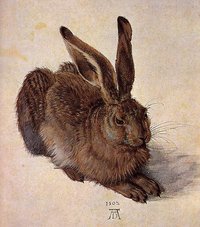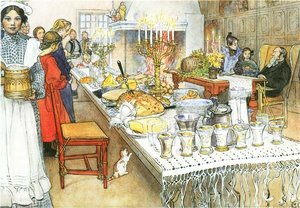Watercolor painting
|
|
Kräftfångst_av_Carl_Larsson_1897.jpg
Watercolor is a painting technique using paint made of colorants suspended or dissolved in water. Although the grounds used in watercolor painting vary, the most common is paper. Others include papyrus, bark papers, plastics, leather, fabric, wood, and canvas.
History of watercolor painting
Watercolor painting began with the invention of paper in China shortly after 100 AD. In the 12th century the conquering Moors introduced papermaking to Spain and the technology spread to Italy decades later. Some of the oldest paper manufactures include Fabriano, Italy, opened in 1276, and Arches, France, opened in 1492.

The forerunner of watercolor painting in Europe was buon fresco painting — wall-painting using pigments in a water medium on wet plaster. One well-known example of buon fresco is the Sistine Chapel, begun in 1508 and completed in 1514.
The earliest known use of European watercolor painting is by Italian Renaissance painter Raffaello Santi (1483-1520), who painted full-scale cartoons as precursors for tapestry designs.
In Germany, Albrecht Dürer (1471-1528) painted watercolors in the 15th century. The first school of watercolor painting in Europe was led by Hans Bol (1534-1593) and was much influenced by Dürer's creations.
Other famous artists have used watercolor painting to supplement their work with oil paint, including van Dyck (1599-1641), Thomas Gainsborough (1727-1788), and John Constable (1776-1837).
In 18th century Britain, Paul Sandby (1725–1809) was called the father of British watercolor.
Watercolor paint
PicabiaFrancis_Riden.jpg
The broader term for water-based painting media is watermedia. The term watercolor most often to refers to traditional transparent watercolor or gouache (an opaque form of the same paint).
Watercolor paint is made of finely-ground pigment or dye mixed with gum arabic for body, and glycerin or honey for viscosity and to bond the colorant to the painting surface. Unpigmented filler is added to gouache to lend opacity to the paint. Oil of clove is used to prevent mold.
Techniques
Traditionally, watercolor paint is applied with brushes, but it may be applied with other implements in experimental approaches or mixed with other materials (usually acrylic or collage).
The paint is thinned before application to allow for lighter areas within the painting. This transparency provides watercolor its characteristics of brightness, sparkle, freshness, and clarity of color since light has passed through the film of paint and is reflected back to the viewer through the film.
According to a tradition, dating from at least the early 20th century, the white of the paper is the only white used in transparent watercolor. Opaque paint is seldom used for whites or to overpaint.
Watercolor techniques have the reputation of being quite demanding, although they are actually no more demanding than those used with other media. Maintaining a high quality of value differences and color clarity are typically the most difficult properties to achieve and maintain.
The medium is effective in portraiture, figurative art, photorealism, and abstract work, both objective and non-objective. (Kandinsky produced the first non-objective abstract paintings in transparent watercolor around 1913).
Watercolor proponents prize it as a studio medium for its lack of odor and ease of cleanup, and also as a plein air medium for its portability and quick drying.
Fingerpainting originated in China with watercolor paints.

